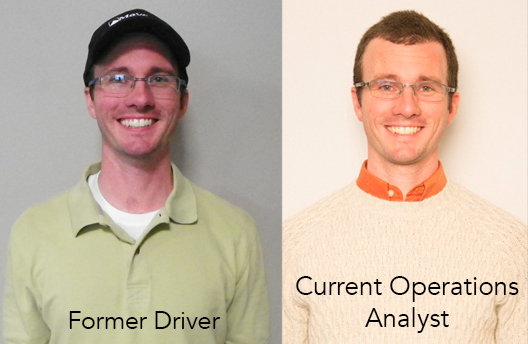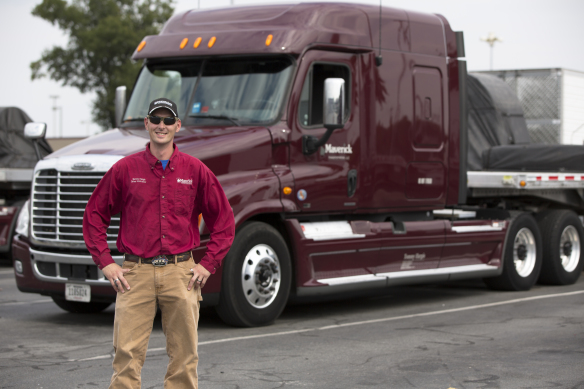- Events
- Interviews
- Uncategorized
Categories
Advice for the Rookie Maverick Driver – Pt. II
Thursday, June 9, 2016
We’re back at it again, folks! For those of you who missed our previous post, we asked a few of our veteran drivers about some of the things they wish they had known before they went out on the road solo. Our first installment came from former driver, driver trainer and now fleet manager TJ Hargis.
Now it’s time for our second installment – this round of advice from former and current drivers Ken Moore and Tom Hachiya.

It’s actually not what a rookie driver does, that’s his/her mistake. It’s what’s not done. Before we start driving, we’re generally used to three square meals at relatively specific times of the day. This can change in a truck. We might not be able to stop for meals at the times we want to due to traffic, appointment times, etc. Now, in order to be our best, to think most clearly, to be safest, and to make our most rational decisions, we need to eat properly and consistently. I’m not talking just eating healthy. When someone first starts driving, there’s so much on his/her plate that food often doesn’t end up on the plate. I’ve spoken with drivers who’ve only eaten fast food and I’ve spoken with drivers who filled their trucks full with cans of beans. We need to eat a variety of food, snack during the day, and pay attention to getting enough non-fast food calories in our system. If we can do this, we are safer, less likely to be irritated by annoying things we have to deal with, and our families will like us more when we get home.
One of the biggest mistakes a rookie driver makes is not finding a way to wind down at the end of the day. When you first start driving, you have a ton to think about: driving safely, appointment times, eating properly in a strange environment, FMCSA regulations, hours of service, and on and on. It’s all pretty daunting in the beginning, and it’s honestly really stressful. If you play guitar, bring your guitar. If you hike, now you can hike everywhere. Personally, I like to find and collect fossils while I’m out. Whatever you choose, you need to have something at the end of the day (and sometimes in the middle) that you can do to help release that stress and feel better. Otherwise, the stress builds day after day and your time on the road isn’t what you want it to be.
From Tom Hachiya:
Time management: Consider your options before you head out on the road. Take some time to think about your 8 hour and 10 hour clock before taking off. The same thing pertains to your 30 minute break. Make sure you have a clear plan and direction, but also keep in mind your options and for hiccups that may come up along the way.
Backing: Make sure you do a good job of surveying your surroundings when you come into a customer’s area. Know where your safety threats and obstacles are at all times. Before you start backing, just stop. Look around and take an inventory of all of those things you might run into or that could hit you: a pedestrian walking along, a car that’s driving, a truck starting up. And as you’re backing up, keep track of them.
Rookies often lose track of the front of their truck. When backing, don’t be so focused that you lose track of the front. Every 10 seconds, look around as you’re backing up so you can keep track of all 4 corners of the truck.
Enjoy being a rookie: When you’re new, people expect you to make mistakes. People don’t expect you to be at 125 PFP points (Pay for Performance). Ask the extra questions, take the extra minutes. When it’s your first time at a customer, let them know. Ask them where they want you to check in, where to park. Don’t worry about the fact that you’re brand new. “Hey I’ve never been here before – where do you want me to go?” You’ll keep yourself out of trouble. Most people are happy to help you – they don’t want to see you fail!
Advice for the Rookie Maverick Driver – Pt. I
Monday, May 2, 2016
We spoke with a few of our Maverick drivers (and former drivers) here recently who are a wealth of knowledge when it comes to the ins and outs of driving OTR. For those of you just starting out as a Maverick, those first few months out on the road going solo can be pretty intimidating. It’s a huge responsibility to be navigating 80,000 pounds of machinery on the roads, highways, and between traffic.
And so begins our short three-part series on some of the most common rookie mistakes and pieces of advice to make those first few months a little easier.
Our first contribution comes from former driver, driver trainer and external recruiter TJ Hargis. TJ is now a fleet manager for Maverick and helps new drivers transition out of their trainer truck and into going solo OTR.
Thanks so much for your time, TJ!

TJ as a driver trainer (2012)
Time management is very important. This covers everything from leaving home too late, just in time to make a delivery, and all the way to taking too long on breaks.
As a new driver, there are many obstacles that we have not seen or experienced, so the best advice that I can give is to plan your day and all your trips with a cushion to allow for road types that you haven’t seen or become comfortable with yet. Then there are other things that might crop up — traffic, time zone differences, even medical issues like when you don’t feel well. These things happen, but if we don’t allow time in our trip planning for them it could result in not loading/unloading for an additional day (which affects our pay check!).
Although it’s tough being away from our families, sometimes it’s actually better to leave a few hours early just to make sure our time is used correctly and we prepare for the obstacles that are in our everyday travels. Make sure to communicate any issues or concerns about your load or even the times and always pay attention to your H.O.S. Call your fleet manager with these questions and ask for their opinion. Remember, we’ve all been in this industry, most of us as drivers, long enough that we can help you find the right plans and path of execution.
Slow down and take your time to ensure that you do your job to the best of your ability and that you do it safely; speed with loading/unloading and trip planning will only get better in time. But find a system that works for you and stick with it. Do everything the same way every time and you create a pattern, a system. Then you can make movements without thinking of them because it becomes second nature. This is when your speed improves. Find a place for all your equipment or instruments that you use on a daily basis and return them to the same place after each use. Being organized is crucial in becoming more efficient.
Don’t ever rely solely on GPS. Always double check your atlas with all routes and restrictions, also use your local directions to get to your shippers and consignees. These are put in by our drivers that have been there before you. You obtain these by sending in Macro 1. Read these directions carefully and write them down. So here is the key to these directions, find out where you will tie in with them because the driver that entered them may have been traveling north (which should be stated) and you may be traveling south, so that means you need to compensate for that. If you have a smart phone, Google Maps works great for seeing your roads on satellite view.
And please, ALWAYS REMEMBER: Communication is the absolute key!
